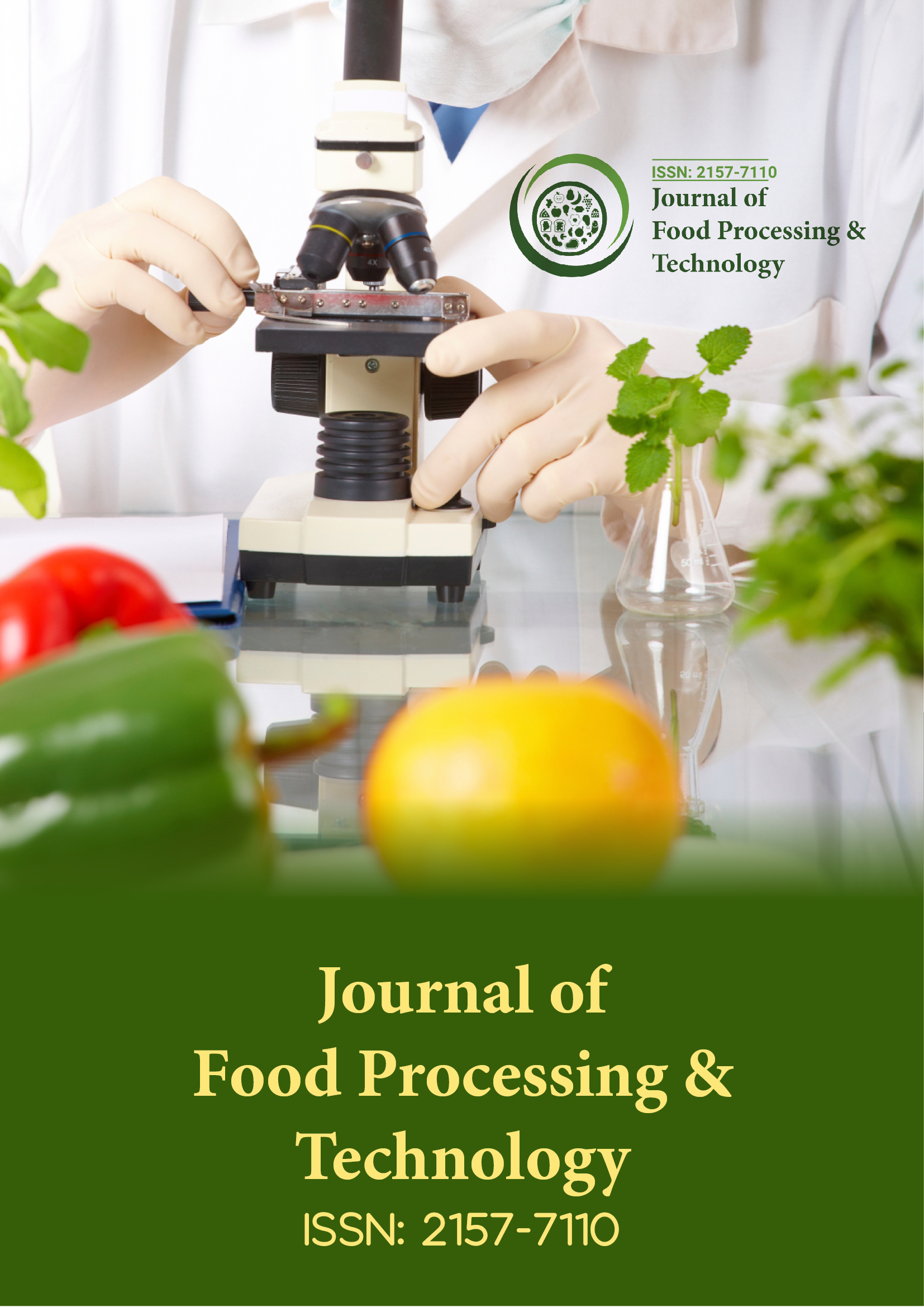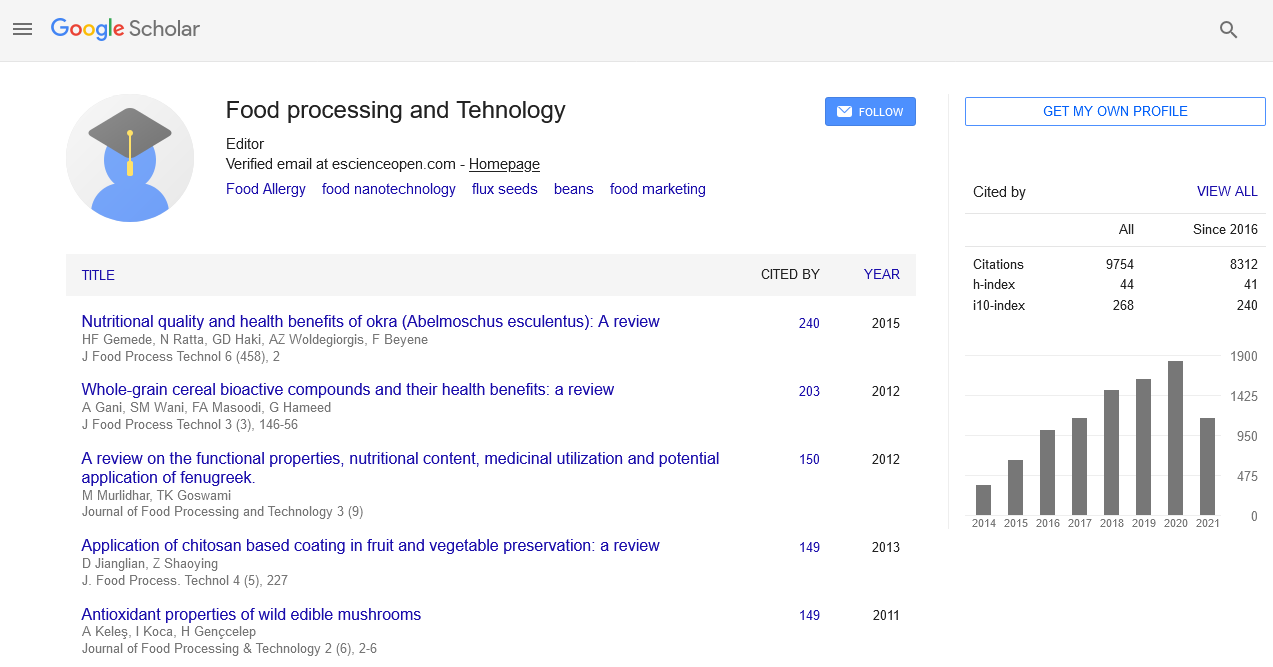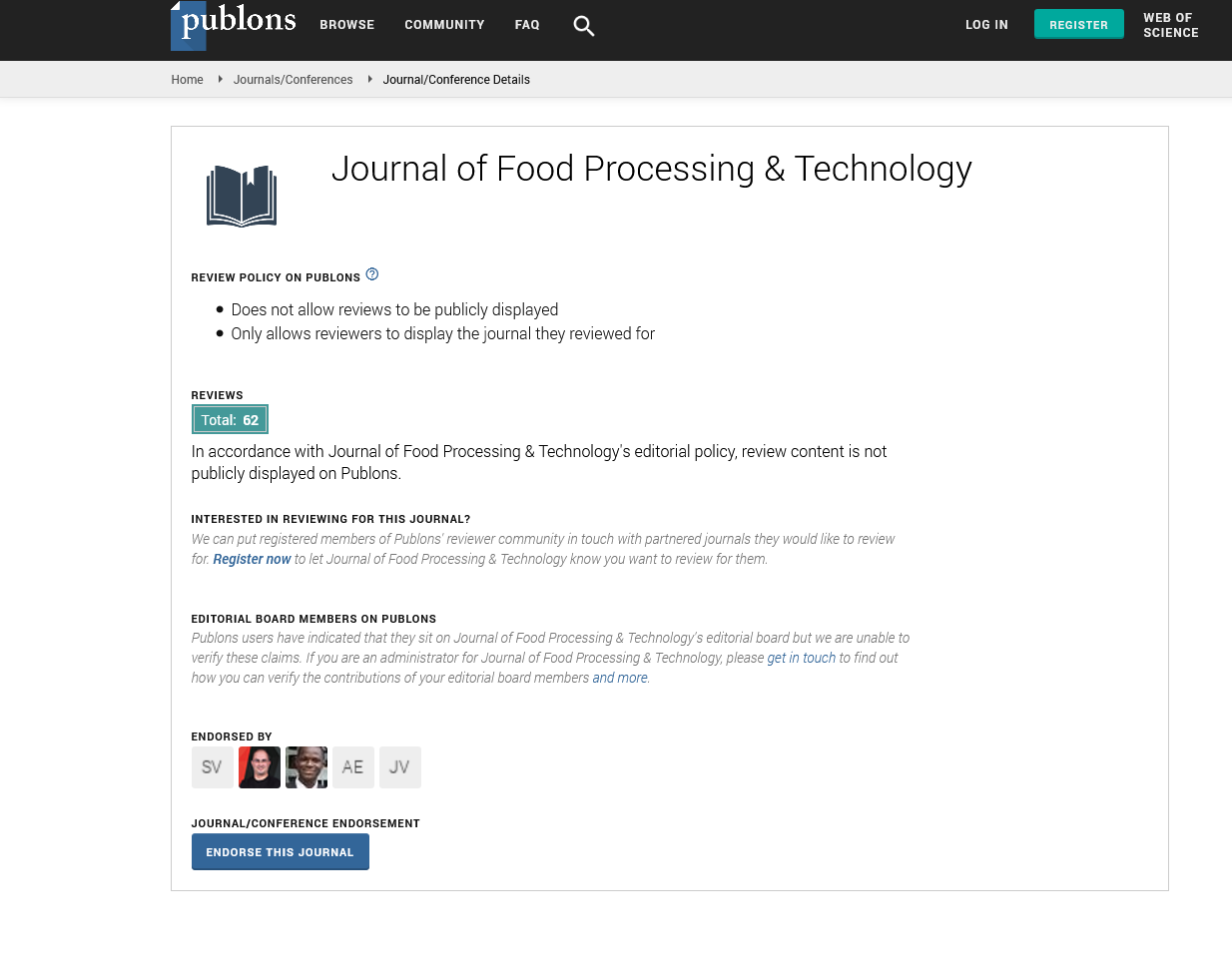Indexed In
- Genamics JournalSeek
- Academic Keys
- JournalTOCs
- China National Knowledge Infrastructure (CNKI)
- Access to Global Online Research in Agriculture (AGORA)
- Centre for Agriculture and Biosciences International (CABI)
- RefSeek
- Directory of Research Journal Indexing (DRJI)
- Hamdard University
- EBSCO A-Z
- OCLC- WorldCat
- Scholarsteer
- SWB online catalog
- Publons
- Euro Pub
- Google Scholar
Useful Links
Share This Page
Journal Flyer

Open Access Journals
- Agri and Aquaculture
- Biochemistry
- Bioinformatics & Systems Biology
- Business & Management
- Chemistry
- Clinical Sciences
- Engineering
- Food & Nutrition
- General Science
- Genetics & Molecular Biology
- Immunology & Microbiology
- Medical Sciences
- Neuroscience & Psychology
- Nursing & Health Care
- Pharmaceutical Sciences
Opinion Article - (2023) Volume 14, Issue 11
Role of Processing Conditions in Enhancing Peptide Stability and Bioactivity in Foods
Wallace Ogugua*Received: 30-Oct-2023, Manuscript No. JFPT-23-24198; Editor assigned: 02-Nov-2023, Pre QC No. JFPT-23-24198 (PQ); Reviewed: 15-Nov-2023, QC No. JFPT-23-24198; Revised: 22-Nov-2023, Manuscript No. JFPT-23-24198 (R); Published: 29-Nov-2023, DOI: 10.35248/2157-7110.23.14.1068
Description
Food processing is a technology that has been used for centuries to preserve, improve flavor, enhance safety and extend shelf life. However, in recent years it has also been utilized to improve the nutritional benefits of food products. In particular, food processing technology has the potential to enhance peptide stability and bioactivity in foods. Peptides are small proteins composed of amino acids, which have various physiological functions in the body. These include regulation of cell growth, tissue repair and metabolism, among others. Thus, it is important to ensure that peptides remain stable during food processing so that their bioactivity is not compromised. Processing conditions such as temperature and pH can significantly influence peptide stability during food processing. Generally, proteins are more stable at lower temperatures as heat can cause them to denature and become less active biologically. Additionally, some pH's are more favorable for protein stability than others; as a result, adjusting the pH of a product can help preserve its peptides during processing. It is also important to consider how different types of processing affect peptide stability; for example, heat treatment or lyophilization (freeze- drying) can be used to increase peptide stability while technologies like homogenization or ultrafiltration may denature proteins. It is important to choose appropriate processing techniques that will not compromise peptide activity.
Food processing can also be used to enhance the bioactivity of peptides in foods. For example, enzymatic hydrolysis can be employed to break down larger proteins into smaller components such as di-, tri-, and oligopeptides which are more easily absorbed by the body and thus have greater biological activity than their whole protein counterparts. Additionally, fermentation processes such as lactic acid fermentation can also be used to generate new peptides with enhanced bioactivities due to the presence of enzymes produced during fermentation which can break down proteins into smaller components with greater biological functions than their larger precursors. In summary, food processing techniques have great potential for improving both the stability and bioactivity of peptides in foods; however it is important to consider how different types of processing conditions might influence protein stability before employing them on a large scale basis. By carefully choosing appropriate techniques that promote rather than degrade peptide stability and bioactivity while preserving flavor and texture attributes desired by consumers, food processors may be able to generate high quality products with enhanced nutritional properties for public consumption.
Common processing techniques and their effects on peptide stability and bioactivity
Food processing is an essential technology in the production of safe, nutritious, and high-quality foods. By controlling the rate of reactions, concentrations of reactants and products, temperature, pH level, or other environmental factors, food processing techniques can help to enhance peptide stability and bioactivity in food products. This article provides an overview of common processing techniques along with their effects on peptide stability and bioactivity.
Enzymatic processes: Enzymatic processes are used to hydrolyze proteins into small peptides with specific activities. Enzymes such as proteases are used to catalyze the hydrolysis reaction which breaks down peptide bonds between amino acids. These enzymatic processes can increase the stability and bioactivity of peptides by increasing their solubility in water or other solvents. In addition, enzymes can be used to modify the structure and function of peptides by introducing new functional groups which may alter its activity or increase its stability against proteolysis.
Heat treatment: Heat treatment is a common technique used in food processing to control microbial growth or denature proteins. High temperatures can lead to protein aggregation which can reduce peptide bioactivity or destabilize them. However, lower heat treatments have been found to increase bioactivity in certain types of peptides due to changes in their tertiary structure that result from unfolding or partial unfolding.
Ultrafiltration: Ultrafiltration is a process that uses membrane filters with nanometer-scale pores to separate different components based on size difference. This technique is often used for purification and concentration purposes but it has also been shown to improve the stability of some types of peptides by removing impurities that could cause degradation.
The effects of different processing conditions on peptide stability and bioactivity are complex but they are important considerations during food production as they can significantly influence the quality and safety of foods. Each type of process must be carefully controlled in order for optimal results but understanding its effects will help to ensure that these processes are used effectively. Food processing technology is an essential component in the production of safe, nutritious, and quality foods. It is also a useful tool for altering peptide stability and bioactivity in foods. By optimizing various processing conditions, manufacturers can enhance the peptide stability and bioactivity of their products, leading to improved functionality and health benefits. This article explores the role of processing conditions in enhancing peptide stability and bioactivity in foods.
Citation: Ogugua W (2023) Role of Processing Conditions in Enhancing Peptide Stability and Bioactivity in Foods. J Food Process Technol. 14:1068.
Copyright: © 2023 Ogugua W. This is an open access article distributed under the terms of the Creative Commons Attribution License, which permits unrestricted use, distribution, and reproduction in any medium, provided the original author and source are credited.


